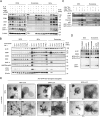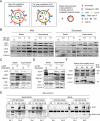External stimulation induces the secretion of autophagosome-like vesicles by B cells
- PMID: 40395311
- PMCID: PMC12039400
- DOI: 10.1080/27694127.2023.2179287
External stimulation induces the secretion of autophagosome-like vesicles by B cells
Abstract
Macroautophagy/autophagy is a cellular degradation and recycling process that supports cellular homeostasis. Since an autophagosome marker, microtubule-associated protein 1A/1B-light chain 3 (LC3)-II, was found in cell-derived extracellular vesicles (EVs), autophagy may cooperate with EV secretion pathways to control unconventional secretion of intracellular molecules. Several studies have demonstrated that pharmacological inhibition of autophagic turnover and pathogen-induced endolysosomal dysfunction enhanced the secretion of autophagosome-like EVs (ALVs). However, whether external stimulation induces ALV secretion is unclear. Here we showed that co-stimulation with IL-4 and anti-CD40 antibody (IL-4:CD40) enhanced the secretion of LC3-II+ALVs compared to co-stimulation by IL-4 and lipopolysaccharide (IL-4:LPS) or by IL4 and anti-IgM antibody in B cells. While IL-4:LPS stimulation accelerated autophagic flux, IL-4:CD40 stimulation reduced autophagosome-lysosome fusion without affecting lysosomal function. Although both IL-4:LPS and IL-4:CD40 induced the expression of similar genes involved in vesicle fusion or transportation, IL-4:CD40 preferentially enhanced the expression of the small GTPase RAB27a compared to IL-4:LPS. Genetic disruption by the CRISPR-Cas9 system revealed that loss of RAB27a membrane-binding ability impaired LC3-II+ALV secretion but not ALIX+EV secretion in B-lymphoma A20 cells. Additionally, reconstitution of human wild-type RAB27A in RAB27a mutant A20 cells restored LC3-II+ALV secretion, indicating that RAB27a controls autophagosome secretion. Furthermore, LC3-II+ALVs were found in the sera of tumor-bearing mice and the plasma of healthy human donors. Our findings may provide a role for B-cell secretory autophagy in regulating intercellular communication under various physiological conditions, such as vaccination, pathogen infection, and B-cell lymphoma progression. Abbreviations: ALVs: autophagosome-like vesicles; ATG: autophagy-related; Baf A1: bafilomycin A1; CNX: calnexin; EVs: extracellular vesicles; Ig: immunoglobulin; IL: Interleukin; LC3: microtubule-associated protein 1A/1B-light; LPS: Lipopolysaccharides; MVs: microvesicles; RAB: member RAS oncogene family; TLR: toll-like receptor.
Keywords: Autophagosome-like vesicles; B-cell activation; CD40 receptor; Extracellular vesicles; IL-4; RAB27a; Secretory autophagy.
© 2023 The Author(s). Published by Informa UK Limited, trading as Taylor & Francis Group.
Conflict of interest statement
No conflicts of interest were disclosed.
Figures




References
-
- Clarke AJ, Simon AK.. Autophagy in the renewal, differentiation and homeostasis of immune cells. Nat Rev Immunol. 2019. Mar;19(3):170–22. - PubMed
LinkOut - more resources
Full Text Sources
Research Materials
Miscellaneous
